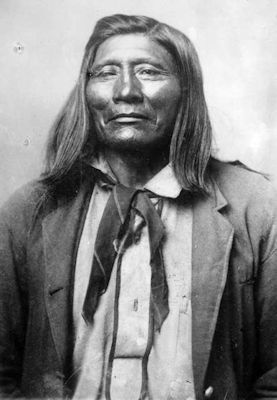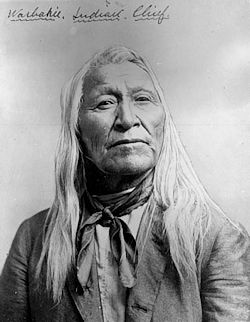Chief Pocatello came to be known in the 1860s among Mormon leaders, Indian agents, and army officers headquartered in the Salt Lake area for his exploits as the head of a so-called outlaw band of Indians.
Famous Shoshone
The Shoshone are an American Indian tribe that have lived in the areas of Idaho, Wyoming, Utah, Nevada and California, with the highest concentration in the Snake River Valley of Idaho. Bios of famous Shoshone chiefs, leaders, and medicine men.
Sacagawea (c. 1788-1812) – She served as an interpreter and guide for the Lewis and Clark expedition, and is the tribe’s most famous member. Sacagawea’s son: Through the mist of two centuries, a portrait emerges
Chief Pocatello a.k.a. Tonaioza (c. 1815-1884) – In 1862, bands of Shoshone under Pocatello’s leadership began to attack wagon trains in southcentral Idaho. The Army retaliated, killing 350 Shoshone in the Bear River Massacre of 1863. Pocatello, recognizing the Shoshone were outmatched, joined other chiefs in signing the Treaty of Box Elder.
Chief Washakie – Was the leader of the Eastern Shoshone. In 1868, Washakie signed the Fort Bridger Treaty, which established the Wind River Reservation.
Chief Bear Hunter a.k.a. Wirasuap (died Jan. 29, 1863) – Was leader of a Shoshone band that lived primarily in the Cache Valley of Utah. It was his band that was attacked at Bear River, resulting in the massacre of nearly the entire band. When Bear Hunter was captured, he was stripped, beaten and whipped, and killed by a heated bayonet run through his ears.Chief Little Soldier –
Shoshone Mike – Lead a band of Bannock Shoshone in 1911 who killed several ranchers.
Cameahwait – Shoshone name for Meriweather Clark, of Lewis & Clark Expedition fame.
Johnathan Pugh – Scout
Lemhi – A Medicine Man of the Shoshone Nation
[PDF] Chief Tendoy (Tin Doi) (1834 – 1907) –
Tendoy II –
Tendoy III –
Chief Sagwitch –
Bannock Chief Tyhee –
Pat L. Tyhee (b. 1853 d. 1924) – The son of Bannock Chief Tyhee, was one of the most photographed Indians of Fort Hall. Images of him date from 1884 to 1924.
Ned Blackhawk – A Te-Moak historian and professor at Yale University.
Mary Dann and Carrie Dann – Western Shoshone activists for cultural and spiritual rights and land rights.
Shoshone Tribes:
Battle Mountain Band, Elko Band Colony, South Fork Reservation and the Wells Band Colony- See Te-Moak Tribe of Western Shoshone Indians of Nevada
Duckwater Shoshone Tribe of the Duckwater Reservation
Shoshone Tribe of the Wind River Reservation (F), Wyoming
Shoshone-Bannock Tribes of the Fort Hall Reservation of Idaho (F)
Shoshone-Paiute Tribes of the Duck Valley Reservation, Nevada (F)
For most modern Wyoming residents and many historians of the American West, the names of Chief Washakie, the Shoshone Indians, and the Wind River Reservation seem inseparable. Yet, it was not always so. The Eastern Shoshone band of American Indians, for whom the Wind River Reservation was created by the Fort Bridger Treaty of 1868, represents an amalgam of various bands of Shoshone and Bannock peoples, most of whom originate from Nevada, Utah, and Idaho, not Wyoming.
Washakie, the best-known leader of the Eastern Shoshones in the latter part of the 19th century, is still considered by some Shoshones as an outsider because he was not a full-blood Shoshone.Indeed, Washakie was of mixed tribal heritage.

